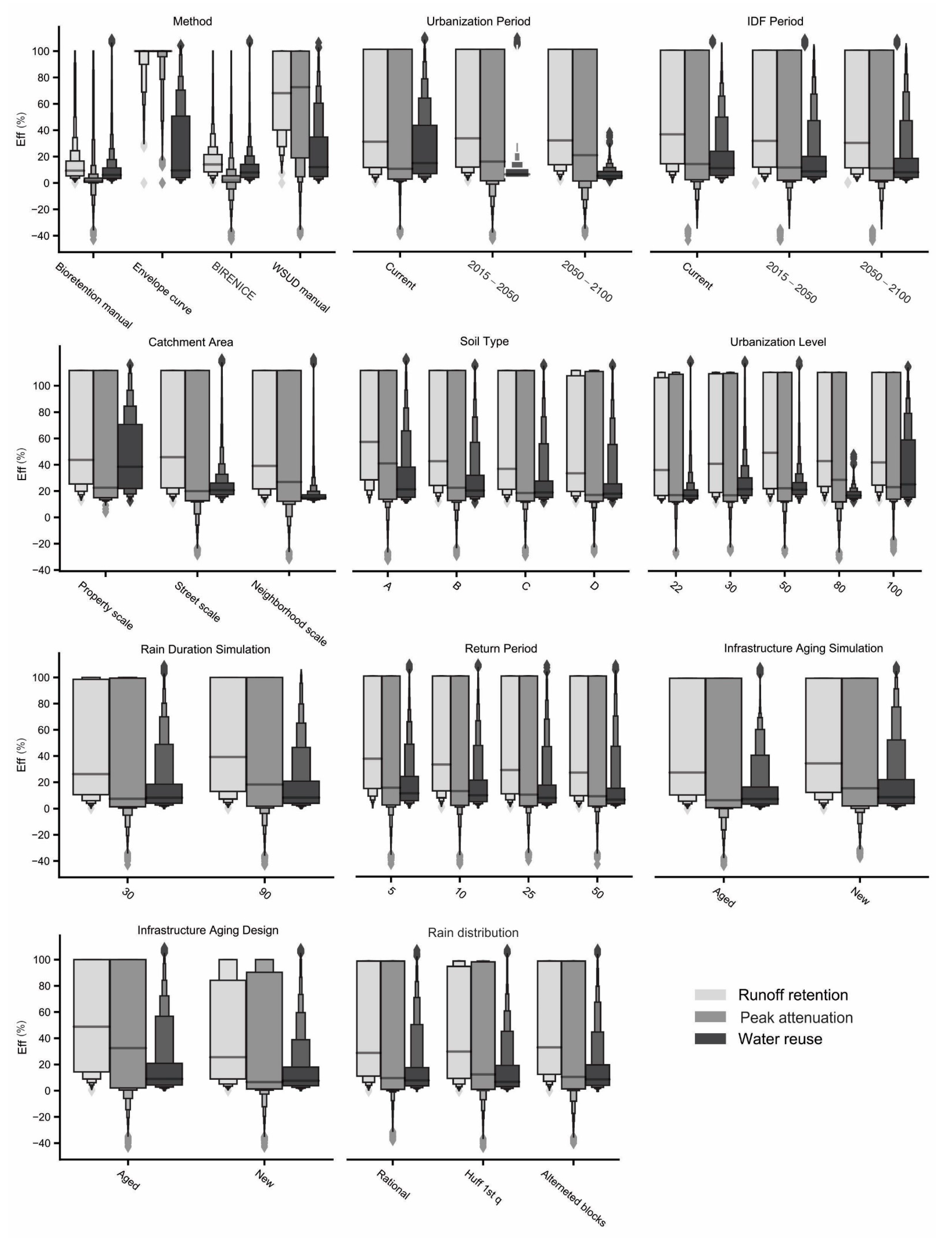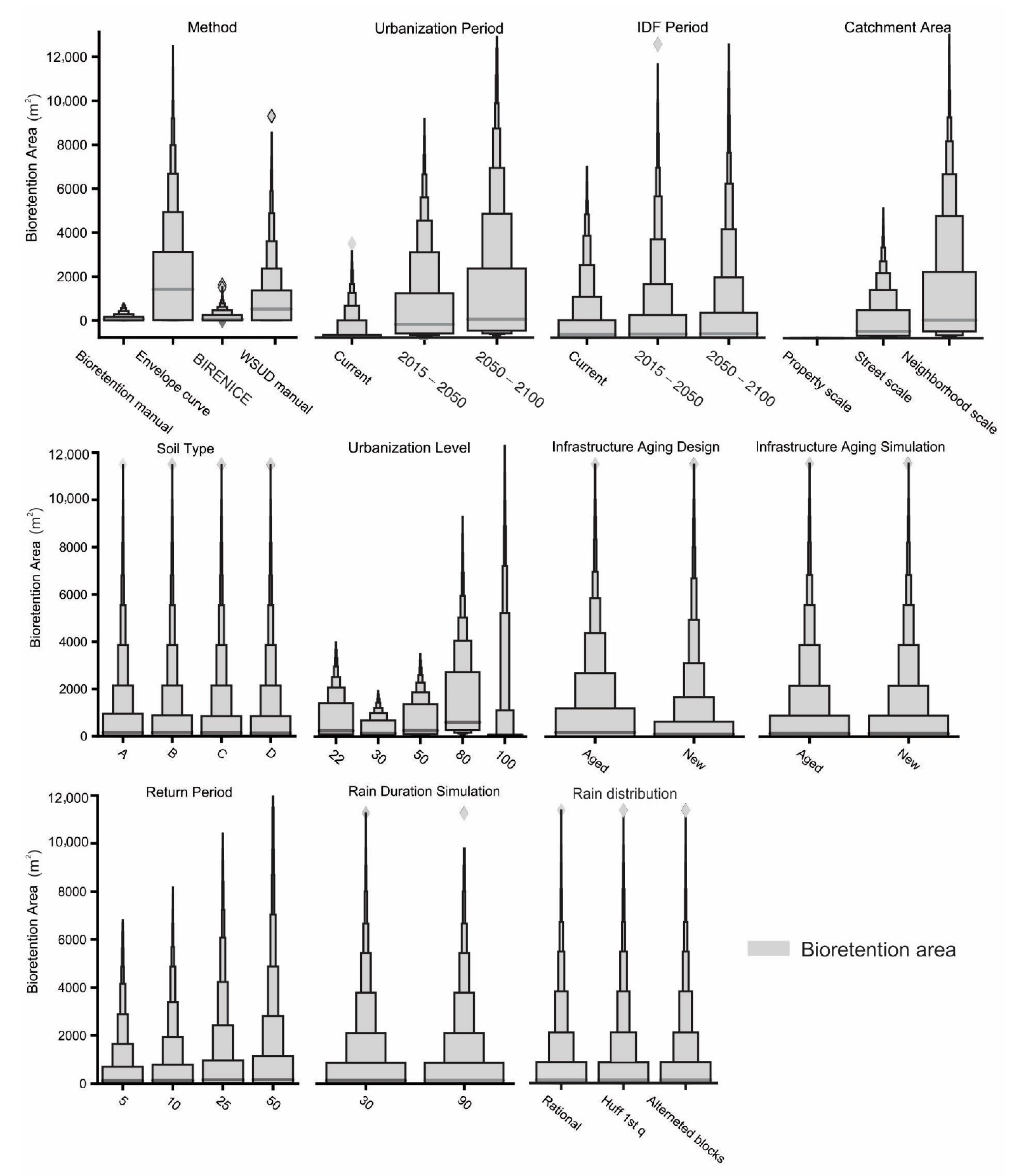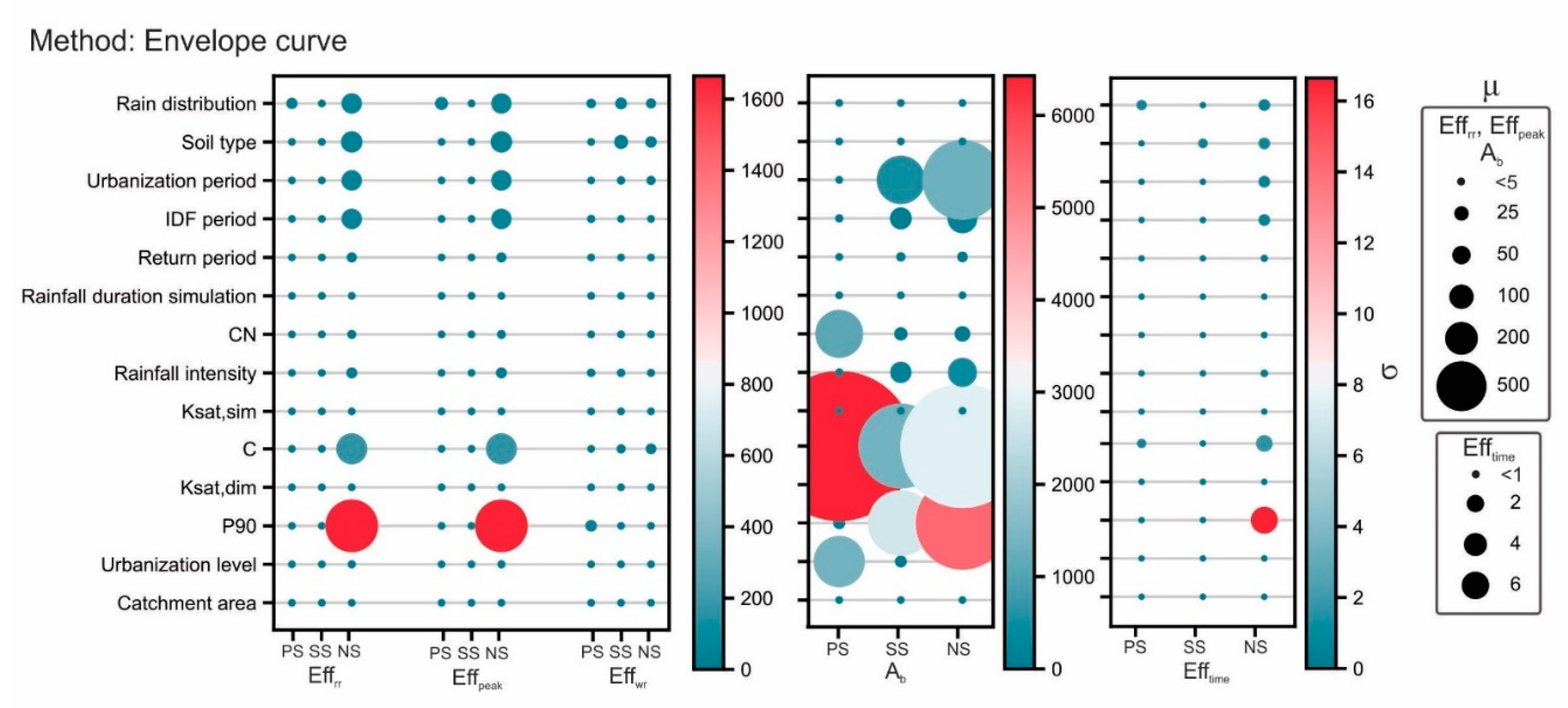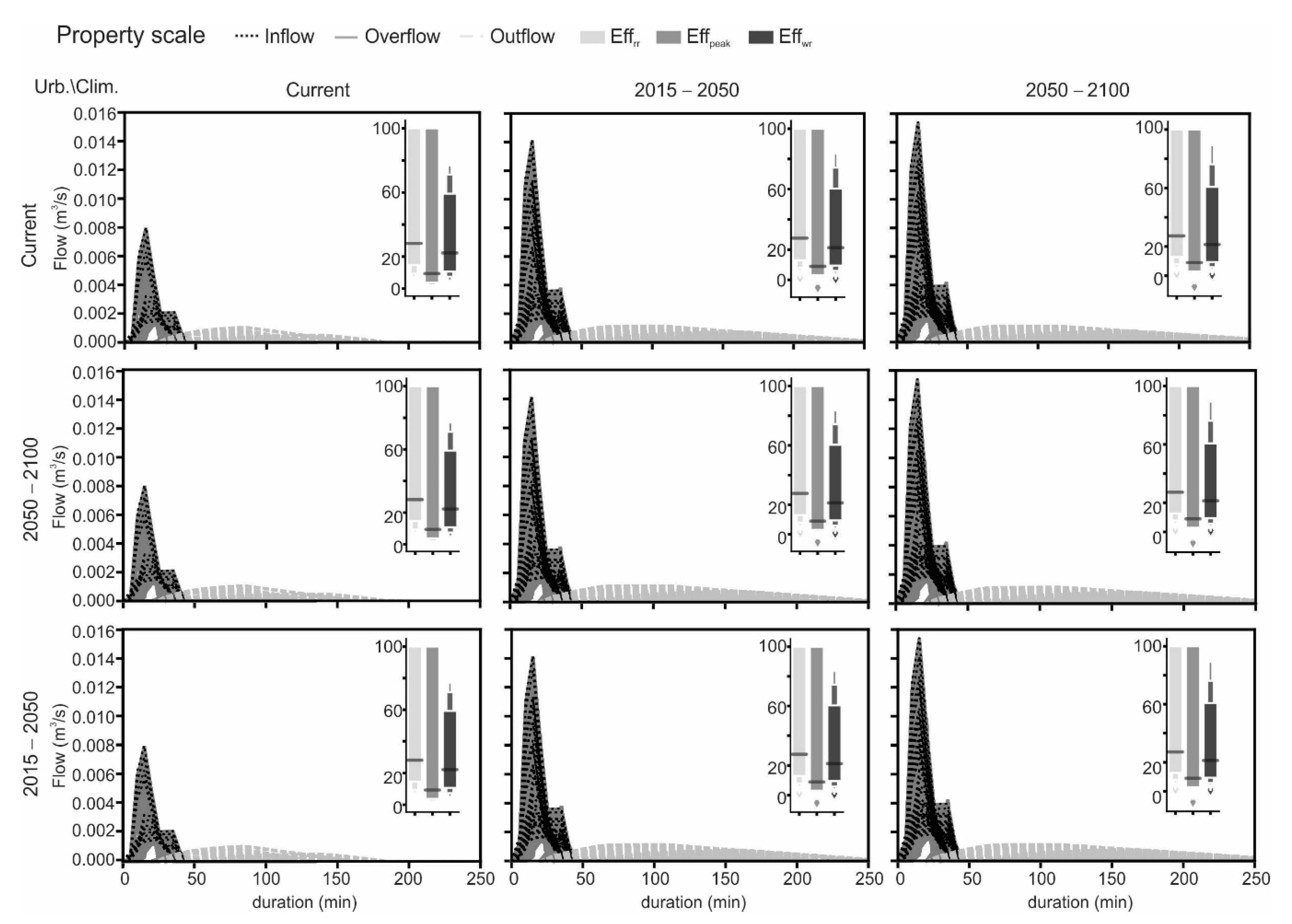Modular Design of Bioretention Systems for Sustainable Stormwater Management under Drivers of Urbanization and Climate Change
Abstract
1. Introduction
2. Methodology
2.1. Parameters and Input Variables Representing Application Site and Design Methods
2.1.1. Study Area and Application Scales
2.1.2. Simplified LID Practice Design and Pre-Sizing
| Method | Design Storm | Mitigation Purpose | Main Parameters | Variables Assumed | Source |
|---|---|---|---|---|---|
| Bioretention manual | Q90 | Water quality | Ac, WQV, Rv, I, K | hb, db, tb, FS, filtering media | [27] |
| Exceedent volume * | |||||
| Peak flow ** | |||||
| WSUD technical guidelines | IDF | Water quality | Ac, C, K, tc | hb, db | [26,28,29] |
| Peak flow * | |||||
| Envelope curve/rain method | IDF, PDF | Exceedent volume | Ac, C | Qs, qs, filtering media | [30,31] |
| Peak flow | |||||
| BIRENICE | IDF | Exceedent volume | Ac, CN, n | Bioretention dimensions (flexible), filtering media | [33] |
| Peak flow ** | |||||
| Water quality *** |
2.2. Parameters and Input Variables Representing Drivers of Change for Future Scenarios
2.2.1. Future Urbanization: Changes in Land Use
2.2.2. Climate Change
2.2.3. Structure Aging
2.3. Simulation Model
2.4. Sensitivity Analysis and Evaluation Functions
3. Results and Discussion
3.1. Changes in Urbanization and Land Use
3.2. Changes in Rainfall Pattern
3.3. Sensitivity Analysis
3.4. Impacts of the Changes in the Catchment Hydrological Behavior and in Bioretention Performance
4. Conclusions
- Changes in climate patterns can be estimated by using Global Circulation Models or Regional Climate Models on the application site. Even with bias correction, these models still have inherent uncertainty which affects bioretention sizing and design. Therefore, ranges of variability should be considered during the calculations. The final choice of which value to adopt within the variability range is based on restrictive design criteria.
- The bioretention surface area has a positive correlation with the efficiencies of runoff retention (r = 0.48) and peak flow attenuation (r = 0.51).
- When evaluating all the combinations between sizing methods, parameters, and input variables, it was possible to observe that the sizing method and the structure aging (represented by the different values in hydraulic conductivity) are the parameters that most affect the final performance of bioretention systems.
- The climate-related variable that most affected the bioretention efficiency was RP.
- The urbanization-related parameters that most affected the bioretention efficiency were the soil type and the runoff coefficient.
- From the sensitivity analysis of the sizing methods, the parameters C and P90 were identified as the most sensitive, with P90 presenting more high-order effects.
Supplementary Materials
Author Contributions
Funding
Institutional Review Board Statement
Informed Consent Statement
Data Availability Statement
Acknowledgments
Conflicts of Interest
References
- Leopold, L.B. Hydrology for Urban Land Planning: A Guidebook on the Hydrological Effects of Urban Land Use; U.S. Geological Survey: Washington, DC, USA, 1968; Volume 554. [Google Scholar]
- Konrad, C.P.; Booth, D.B. Hydrologic changes in urban streams and their Ecological significance. Am. Fish. Soc. Symp. 2005, 47, 157–177. [Google Scholar]
- Wong, T.H.F.; Eadie, M.L. Water sensitive urban design—A paradigm shift in urban design. In Proceedings of the Xth World Water Congress, Melbourne, Australia, 12–16 March 2000; Available online: http://gabeira.locaweb.com.br/cidadesustentavel/biblioteca/%7B30788FE6-98A8-44E5-861E-996D286A78B3%7D_Wong1.pdf (accessed on 10 October 2020).
- Santos, R.F. Vulnerabilidade Ambiental: Desastres Naturais ou Fenômenos Induzidos? [Environmental Vulnerability: Natural Disasters or Induced Phenomena?]; MMA: Brasilia, Brazil, 2007. (In Portuguese) [Google Scholar]
- Young, C.E.F.; Aguiar, C.; Souza, E. Valorando Tempestades: Custo Econômico dos Eventos Climáticos Extremos no Brasil nos Anos de 2002–2012 [Assessing Storms: Economic Cost of Extreme Weather Events in Brazil in the Years 2002–2012], 1st ed.; Observatório do Clima: São Paulo, Brazil. (In Portuguese)
- Debortoli, N.S.; Camarinha, P.I.M.; Marengo, J.A.; Rodrigues, R.R. An index of Brazil’s vulnerability to expected increases in natural flash flooding and landslide disasters in context of climate change. Nat. Hazards 2017, 86, 557–582. [Google Scholar] [CrossRef]
- Marengo, J.A.; Schaeffer, R.; Zee, D.; Pinto, H.S. Mudanças Climáticas e Eventos Extremos no Brasil [Climate Change and Extreme Events in Brazil]. 2010. Available online: http://www.fbds.org.br/cop15/FBDS_MudancasClimaticas.pdf (accessed on 10 October 2010). (In Portuguese).
- IPCC. Climate Change 2021—The Physical Science Basis. Working Group I Contribution to the Sixth Assessment Report of the Intergovernmental Panel of Climate Change; IPCC: Geneva, Switzerland, 2021. [Google Scholar]
- Houston, D.; Werritty, A.; Bassett, D. Pluvial (Rain-Related) Flooding in Urban Areas: The Invisible Hazard. Joseph Rowntree Foundation. Available online: http://www.jrf.org.uk/sites/files/jrf/urban-flood-risk-full.pdf (accessed on 10 March 2019).
- C40. Climate Action in Megacities: C40 Cities Baseline and Opportunities. Volume 2.0. February 2014. Available online: http://issuu.com/c40cities/docs/c40_climate_action_in_megacities/149?e=10643095/6541335 (accessed on 12 April 2018).
- Fletcher, T.D.; Shuster, W.; Hunt, W.F.; Ashley, R.; Butler, D.; Arthur, S.; Viklander, M. SUDS, LID, BMPs, WSUD and more–The evolution and application of terminology surrounding urban drainage. Urban Water J. 2015, 12, 525–542. [Google Scholar] [CrossRef]
- Macedo, M.B.; Gomes Junior, M.N.; Oliveira, T.R.P.; HGiacomoni, M.; Imani, M.; Zhang, K.; Ambrogi Ferreira do Lago, C.; Mendiondo, E.M. Low Impact Development practices in the context of United Nations Sustainable Development Goals: A new concept, lessons learned and challenges. Crit. Rev. Environ. Sci. Technol. 2021, 52, 2538–2581. [Google Scholar] [CrossRef]
- Laurenson, G.; Laurenson, S.; Bolan, N.; Beecham, S.; Clark, I. The role of bioretention systems in the treatment of stormwater. Adv. Agron. 2013, 120, 223–274. [Google Scholar]
- Liu, Y.; Engel, B.A.; Collingsworth, P.D.; Pijanowski, B.C. Optimal implementation of green infrastructure practices to minimize influences of land use change and climate change on hydrology and water quality: Case study in Spy Run Creek watershed, Indiana. Sci. Total Environ. 2017, 601, 1400–1411. [Google Scholar] [CrossRef]
- Liu, Y.; Theller, L.O.; Pijanowski, B.C.; Engel, B.A. Optimal selection and placement of green infrastructure to reduce impacts of land use change and climate change on hydrology and water quality: An application to the Trail Creek Watershed, Indiana. Sci. Total Environ. 2016, 553, 149–163. [Google Scholar] [CrossRef] [PubMed]
- Pyke, C.; Warren, M.P.; Johnson, T.; LaGro, J., Jr.; Scharfenberg, J.; Groth, P.; Freed, R.; Schroeer, W.; Main, E. Assessment of low impact development for managing stormwater with changing precipitation due to climate change. Landsc. Urban Plan. 2011, 103, 166–173. [Google Scholar] [CrossRef]
- Semadeni-Davies, A.; Hernebring, C.; Svensson, G.; Gustafsson, L.G. The impacts of climate change and urbanisation on drainage in Helsingborg, Sweden: Suburban stormwater. J. Hydrol. 2008, 350, 114–125. [Google Scholar] [CrossRef]
- Willems, P. Revision of urban drainage design rules after assessment of climate change impacts on precipitation extremes at Uccle, Belgium. J. Hydrol. 2013, 496, 166–177. [Google Scholar] [CrossRef]
- Madsen, H.; Lawrence, D.; Lang, M.; Martinkova, M.; Kjeldsen, T.R. Review of trend analysis and climate change projections of extreme precipitation and floods in Europe. J. Hydrol. 2014, 519, 3634–3650. [Google Scholar] [CrossRef]
- DeGaetano, A.T.; Castellano, C.M. Future projections of extreme precipitation intensity-duration-frequency curves for climate adaptation planning in New York State. Clim. Serv. 2017, 5, 23–35. [Google Scholar] [CrossRef]
- INMET—Instituto Nacional de Meteorologia. Normais Climatológicas do Brasil [Brazilian Climatological Norms]. 2016. Available online: https://portal.inmet.gov.br/normais (accessed on 10 October 2021). (In Portuguese)
- Fava, M.C.; Abe, N.; Restrepo-Estrada, C.; Kimura, B.Y.; Mendiondo, E.M. Flood modelling using synthesised citizen science urban streamflow observations. J. Flood Risk Manag. 2018, 12, e12498. [Google Scholar] [CrossRef]
- Abreu, F.G. Quantificação dos Prejuízos Econômicos à Atividade Comercial Derivados de Inundações Urbanas [Quantification of Economic Losses to Commercial Activity Derived from Urban Flooding]. Ph.D. Thesis, Escola de Engenharia de São Carlos, Universidade de São Paulo, São Carlos, Brazil, 2019. (In Portuguese). [Google Scholar]
- PMSC—Prefeitura Municipal de São Carlos. Plano Diretor do Município de São Carlos. Lei no 18.053, de 19 de Dezembro de 2016 [Master Plan of the Municipality of São Carlos. Law 18.053 of 19 December 2016]. 2016. Available online: https://leismunicipais.com.br/plano-diretor-sao-carlos-sp (accessed on 11 September 2019). (In Portuguese)
- Marsalek, J.; Schreier, H. Innovation in Stormwater Management in Canada: The Way Forward, Water Quality Resources. Water Qual. Res. J. 2009, 44, v–x. [Google Scholar] [CrossRef]
- Waterways, M.B. Water Sensitive urban Design: Technical Design Guidelines for South East Queensland. Moreton Bay Waterways and Catchment Partnership. 2005. Available online: https://www.brisbane.qld.gov.au/planning-and-building/planning-guidelines-and-tools/brisbane-city-plan-2014/superseded-brisbane-city-plan-2000/superseded-subdivision-and-development-guidelines/water-sensitive-urban-design/engineering-guidelines-superseded (accessed on 28 August 2020).
- Bioretention Manual; Environmental Services Division, Department of Environmental Resources: Prince George’s County, MD, USA. 2007. Available online: https://www.ct.gov/deep/lib/deep/p2/raingardens/bioretention_manual_2009_version.pdf (accessed on 25 September 2018).
- COUNCIL, Gold Coast City. Water Sensitive Urban Design Guidelines; Gold Coast City Council: Queensland, Australia, 2007. [Google Scholar]
- McAuley, A. Technical Design Guidelines; Northern Territory Department of Planning and Infrastructure: Darwin, Australia, 2009. [Google Scholar]
- Urbonas, B.; Stahre, P. Stormwater: Best Management Practices and Detention for Water Quality, Drainage, and CSO Management; Prentice Hall: Hoboken, NJ, USA, 1993. [Google Scholar]
- Silveira, A.L.L.; Goldenfum, J.A. Metodologia Generalizada para Pré-Dimensionamento de Dispositivos de Controle Pluvial na Fonte [Generalized Methodology for Pre-Dimensioning of Rainwater Control Devices at Source]. RBRH 2007, 12, 57–168. (In Portuguese) [Google Scholar] [CrossRef]
- Chow, V.T.; Maidment, D.R.; Larry, W. Mays. In Applied Hydrology, International ed.; MacGraw-Hill Inc.: New York, NY, USA, 1988; p. 149. [Google Scholar]
- Rosa, A. Bioretention for Diffuse Pollution Control in SUDS Using Experimental-Adaptive Approaches of Ecohydrology. Ph.D. Thesis, Escola de Engenharia de São Carlos, Universidade de São Paulo, São Carlos, Brazil, 2016. [Google Scholar]
- Hunt, W.; Lord, B.; Loh, B.; Sia, A. Plant Selection for Bioretention Systems and Stormwater Treatment Practices. In Springer Briefs in Water Science and Technology; Springer: New York, NY, USA, 2015. [Google Scholar]
- Canholi, A.P. Drenagem Urbana e Controle de Enchentes [Urban Drainage and Floods Control], 2nd ed.; Oficina de Textos: São Paulo, Brazil, 2014. (In Poruguese) [Google Scholar]
- Madsen, H.; Arnbjerg-Nielsen, K.; Mikkelsen, P.S. Update of regional intensity–duration–frequency curves in Denmark: Tendency towards increased storm intensities. Atmos. Res. 2009, 92, 343–349. [Google Scholar] [CrossRef]
- Soro, G.E.; Goula-Bi, T.A.; Kouassi, F.W.; Srohourou, B. Update of intensity duration frequency curves for precipitation of short durations in tropical area of West Africa (Côte D’ivoire). J. Appl. Sci. 2010, 10, 704–715. [Google Scholar] [CrossRef]
- Mailhot, A.; Duchesne, S. Design criteria of urban drainage infrastructures under climate change. J. Water Resour. Plan. Manag. 2009, 136, 201–208. [Google Scholar] [CrossRef]
- Wang, D.; Hagen, S.C.; Alizad, K. Climate change impact and uncertainty analysis of extreme rainfall events in the Apalachicola River basin, Florida. J. Hydrol. 2013, 480, 125–135. [Google Scholar] [CrossRef]
- De Paola, F.; Galdiero, E.; Giugni, M.; Pugliese, F. Sustainable development of storm-water systems in African cities considering climate change. Procedia Eng. 2015, 119, 1181–1191. [Google Scholar] [CrossRef]
- Chou, S.C.; Lyra, A.; Mourão, C.; Dereczynski, C.; Pilotto, I.; Gomes, J.; Bustamante, J.; Tavares, P.; Silva, A.; Rodrigues, D.; et al. Assessment of climate change over South America under RCP 4.5 and 8.5 downscaling scenarios. Am. J. Clim. Chang. 2014, 3, 512–525. [Google Scholar] [CrossRef]
- Lyra, A.; Tavares, P.; Chou, S.C.; Sueiro, G.; Dereczynski, C.; Sondermann, M.; Silva, A.; Marengo, J.; Giarolla, A. Climate change projections over three metropolitan regions in Southeast Brazil using the non-hydrostatic Eta regional climate model at 5-km resolution. Theor. Appl. Climatol. 2018, 132, 663–682. [Google Scholar] [CrossRef]
- Teutschbein, C.; Seibert, J. Bias correction of regional climate model simulations for hydrological climate-change impact studies: Review and evaluation of different methods. J. Hydrol. 2012, 456, 12–29. [Google Scholar] [CrossRef]
- Willems, P.; Vrac, M. Statistical precipitation downscaling for small-scale hydrological impact investigations of climate change. J. Hydrol. 2011, 402, 193–205. [Google Scholar] [CrossRef]
- Pachauri, R.K.; Meyer, L.A. (Eds.) IPCC, 2014: Climate Change 2014: Synthesis Report. Contribution of Working Groups I, II and III to the Fifth Assessment Report of the Intergovernmental Panel on Climate Change; IPCC: Geneva, Switzerland, 2014; p. 151. [Google Scholar]
- Levine, D.M.; Berenson, M.L.; Stephan, D. Estatística—Teoria e Aplicações [Statistics—Theory and Applications], 5th ed.; LTC: Rio de Janeiro, Brazil, 2008. (In Portuguese) [Google Scholar]
- Barbassa, A.P. Simulação do Efeito da Urbanização Sobre a Drenagem Pluvial da Cidade de São Carlos—SP [Simulation of the Effect of Urbanization on the Storm Drainage of the City of São Carlos—SP]. Doctoral thesis, Escola de Engenharia de São Carlos, Universidade de São Paulo, São Carlos, Brazil, 1991. (In Portuguese). [Google Scholar]
- Koutsoyiannis, D.; Kozonis, D.; Manetas, A. A mathematical framework for studying rainfall intensity-duration-frequency relationships. J. Hydrol. 1998, 206, 118–135. [Google Scholar] [CrossRef]
- Lehmann, E.A.; Phatak, A.; Stephenson, A.; Lau, R. Spatial modelling framework for the characterisation of rainfall extremes at different durations and under climate change. Environmetrics 2016, 27, 239–251. [Google Scholar] [CrossRef]
- Muller, A.; Bacro, J.N.; Lang, M. Bayesian comparison of different rainfall depth–duration–frequency relationships. Stoch. Environ. Res. Risk Assess. 2008, 22, 33–46. [Google Scholar] [CrossRef]
- Gomes Junior, M.N. Aspectos Hidrológicos-Hidráulicos e Avaliação da Eficiência de Biorretenções: Modelos, Princípios e Critérios de Projeto de Técnicas Compensatórias de 3ª Geração [Hydrological-Hydraulic Aspects and Evaluation of Bioretention Efficiency: Models, Principles and Design Criteria for 3rd Generation LID]. Master’s Thesis, Escola de Engenharia de São Carlos, Universidade de São Paulo, São Carlos, Brazil, 2019. (In Portuguese). [Google Scholar]
- São Paulo (cidade). Secretaria Municipal de Desenvolvimento Urbano. In Manual de Drenagem e Manejo de Águas Pluviais: Aspectos Tecnológicos; diretrizes para projetos; SMDU: São Paulo, Brazil, 2012. [Google Scholar]
- Tucci, C.E. Hidrologia: Ciência e Aplicação, 2nd ed.; Universidade/UFRGS/ABRH: Porto Alegre, Brazil, 2001. [Google Scholar]
- Randelovic, A.; Zhang, K.; Jacimovic, N.; McCarthy, D.; Deletic, A. Stormwater biofilter treatment model (MPiRe) for selected micro-pollutants. Water Res. 2016, 89, 180–191. [Google Scholar] [CrossRef]
- Shen, P.; Deletic, A.; Urich, C.; Chandrasena, G.I.; McCarthy, D.T. Stormwater biofilter treatment model for faecal microorganisms. Sci. Total Environ. 2018, 630, 992–1002. [Google Scholar] [CrossRef]
- Macedo, M.B.; Oliveira, T.R.P.; Oliveira, T.H.; Gomes Junior, M.N.; Brasil, J.A.T.; do Lago, C.A.F.; Mendiondo, E.M. Evaluating low impact development practices potentials for increasing flood resilience and stormwater reuse through lab-controlled bioretention systems. Water Sci. Technol. 2021, 84, 1103–1124. [Google Scholar] [CrossRef]
- Song, X.; Zhang, J.; Zhan, C.; Xuan, Y.; Ye, M.; Xu, C. Global sensitivity analysis in hydrological modeling: Review of concepts, methods, theoretical framework, and applications. J. Hydrol. 2015, 523, 739–757. [Google Scholar] [CrossRef]
- Morris, M.D. Factorial sampling plans for preliminary computational experiments. Technometrics 1991, 33, 161–174. [Google Scholar] [CrossRef]
- Campolongo, F.; Cariboni, J.; Saltelli, A. An effective screening design for sensitivity analysis of large models. Environ. Model. Softw. 2007, 22, 1509–1518. [Google Scholar] [CrossRef]
- Hofmann, H.; Wickham, H.; Kafadar, K. Letter-value plots: Boxplots for large data. J. Comput. Graph. Stat. 2017, 26, 469–477. [Google Scholar] [CrossRef]
- Dudula, J.; Randhir, T.O. Modelling the influence of climate change on watershed systems: Adaptation through targeted practices. J. Hydrol. 2016, 541, 703–713. [Google Scholar] [CrossRef]
- Ghazal, R.; Ardeshir, A.; Rad, I.Z. Climate change and stormwater management strategies in Tehran. Procedia Eng. 2014, 89, 780–787. [Google Scholar] [CrossRef][Green Version]
- Hathaway, J.M.; Brown, R.A.; Fu, J.S.; Hunt, W.F. Bioretention function under climate change scenarios in North Carolina, USA. J. Hydrol. 2014, 519, 503–511. [Google Scholar] [CrossRef]
- Dussaillant, A.R.; Wu, C.H.; Potter, K.W. Richards equation model of a rain garden. J. Hydrol. Eng. 2004, 9, 219–225. [Google Scholar] [CrossRef]















| Parameter | Description | Value | Unit | Acquisition |
|---|---|---|---|---|
| hp | Height of the ponding zone | 0.3 | m | Adopted in design |
| Hsm | Height of soil mix layer | 1.0 | m | Adopted in design |
| Hg | Height of gravel layer | 0.2 | m | Adopted in design |
| nsm | Soil mix porosity | 0.32 | - | Adopted in design |
| ng | Gravel porosity | 0.4 | - | Adopted in design |
| tb | Emptying time | 24 | h | Adopted in design |
| Ksat | Hydraulic conductivity | See Section 2.2.3 | mm/h | Adopted in design |
| FS | Safety factor | 2 | - | Adopted in design |
| Kc | Evapotranspiration constant for plants | 1.38 | - | Calibrated |
| Kweir | Weir coefficient | 1.3 | - | Adopted in design |
| Expweir | Weir exponent | 2.5 | - | Adopted in design |
| sh | Hydroscopic soil moisture | 0.036 | - | Calibrated |
| sw | Wilting point moisture | 0.120 | - | Calibrated |
| sfc | Field capacity | 0.435 | - | Calibrated |
| ss | Plant stress moisture | 0.482 | - | Calibrated |
| hpipe | Height of underdrain pipe | 0.2 | m | Adopted in design |
| dpipe | Underdrain pipe diameter | 32 | mm | Adopted in design |
| Cd | Discharge coefficient for the pipe | 0.33 | - | Calibrated |
| Δt | Time-step | 5 | min | Adopted in simulation |
| Street Scale | Neighborhood Scale | |||||
|---|---|---|---|---|---|---|
| Current | 2015–2050 | 2050–2100 | Current | 2015–2050 | 2050–2100 | |
| (50% Urbanization) | (80% Urbanization) | (80% Urbanization) | (100% Urbanization) | |||
| Aunderbrush (m2) | 15,973 | 11,500 | 3514 | 36,789 | 11,809 | 1104 |
| Aroof (m2) | 573 | 5046 | 13,032 | 4877 | 29,856 | 40,562 |
| Asidewalk (m2) | 1910 | 1910 | 1910 | - | - | - |
| Astreet (m2) | 4550 | 4550 | 4550 | 5940 | 5940 | 5940 |
| Atotal (m2) | 23,006 | 23,006 | 23,006 | 47,606 | 47,606 | 47,606 |
| C | 0.4 | 0.6 | 0.8 | 0.4 | 0.7 | 0.9 |
| CNA | 62 | 72 | 89 | 60 | 86 | 97 |
| CNB | 77 | 82 | 92 | 76 | 91 | 97 |
| CNC | 84 | 88 | 94 | 83 | 93 | 98 |
| CND | 88 | 90 | 95 | 87 | 95 | 98 |
| Current | MIROC5 4.5 PT | MIROC5 4.5 MD | MIROC5 8.5 PT | MIROC5 8.5 MD | |
|---|---|---|---|---|---|
| 2015–2050 | |||||
| K | 819.67 | 772.4 | 764.56 | 899.82 | 890.51 |
| m | 0.138 | 0.311 | 0.2956 | 0.2182 | 0.2176 |
| t0 | 10.77 | 12 | 12 | 12 | 12 |
| n | 0.75 | 0.764 | 0.764 | 0.764 | 0.764 |
| 2050–2100 | |||||
| K | 819.67 | 1007.77 | 965.93 | 1036.49 | 1034.01 |
| m | 0.138 | 0.2645 | 0.2113 | 0.2356 | 0.2007 |
| t0 | 10.77 | 12 | 12 | 12 | 12 |
| n | 0.75 | 0.764 | 0.764 | 0.764 | 0.764 |
| Parameter/Input Variable | Unit | Base Values | Range | ||
|---|---|---|---|---|---|
| PS | SS | NS | |||
| Catchment area | (m2) | 94 | 23,000 | 47,600 | 94, 23,000, 47,600 |
| Method | Each method | Bioretention manual, BIRENICE, Envelope curve, WSUD manual | |||
| Urbanization period | Current | Current, 2015–2050, 2050–2100 | |||
| IDF period | Current | Current, 2015–2050, 2050–2100 | |||
| IDF coefficients | IDF current period | See Table 5 | |||
| Soil type | A | A, B, C, D | |||
| Urbanization level | (%) | 100 | 30 | 22 | 22, 30, 50, 80, 100 |
| Rain duration simulation | (min) | 30 | 30, 90 | ||
| Return period | (Years) | 5 | 5, 10, 25, 50 | ||
| Ksat,sim | (mm/h) | 195 | 195, 468 | ||
| Ksat,dim | (mm/h) | 195 | 195, 468 | ||
| Rain intensity | (mm/h) | 63.44 | Calculated according to IDF and rain duration | ||
| CN | (-) | CN current period soil A | See Table 4 | ||
| C | (-) | 0.9 | 0.4 | 0.4 | 0.4, 0.6, 0.7, 0.8, 0.9 |
| Rain distribution | Alternated blocks | Alternated blocks, Huff 1st quartile, Rational | |||
| P90 | (mm) | 32.5 | Calculated according to daily rainfall in future climate projections | ||
Publisher’s Note: MDPI stays neutral with regard to jurisdictional claims in published maps and institutional affiliations. |
© 2022 by the authors. Licensee MDPI, Basel, Switzerland. This article is an open access article distributed under the terms and conditions of the Creative Commons Attribution (CC BY) license (https://creativecommons.org/licenses/by/4.0/).
Share and Cite
Batalini de Macedo, M.; Gomes Júnior, M.N.; Jochelavicius, V.; de Oliveira, T.R.P.; Mendiondo, E.M. Modular Design of Bioretention Systems for Sustainable Stormwater Management under Drivers of Urbanization and Climate Change. Sustainability 2022, 14, 6799. https://doi.org/10.3390/su14116799
Batalini de Macedo M, Gomes Júnior MN, Jochelavicius V, de Oliveira TRP, Mendiondo EM. Modular Design of Bioretention Systems for Sustainable Stormwater Management under Drivers of Urbanization and Climate Change. Sustainability. 2022; 14(11):6799. https://doi.org/10.3390/su14116799
Chicago/Turabian StyleBatalini de Macedo, Marina, Marcus Nóbrega Gomes Júnior, Vivian Jochelavicius, Thalita Raquel Pereira de Oliveira, and Eduardo Mario Mendiondo. 2022. "Modular Design of Bioretention Systems for Sustainable Stormwater Management under Drivers of Urbanization and Climate Change" Sustainability 14, no. 11: 6799. https://doi.org/10.3390/su14116799
APA StyleBatalini de Macedo, M., Gomes Júnior, M. N., Jochelavicius, V., de Oliveira, T. R. P., & Mendiondo, E. M. (2022). Modular Design of Bioretention Systems for Sustainable Stormwater Management under Drivers of Urbanization and Climate Change. Sustainability, 14(11), 6799. https://doi.org/10.3390/su14116799









